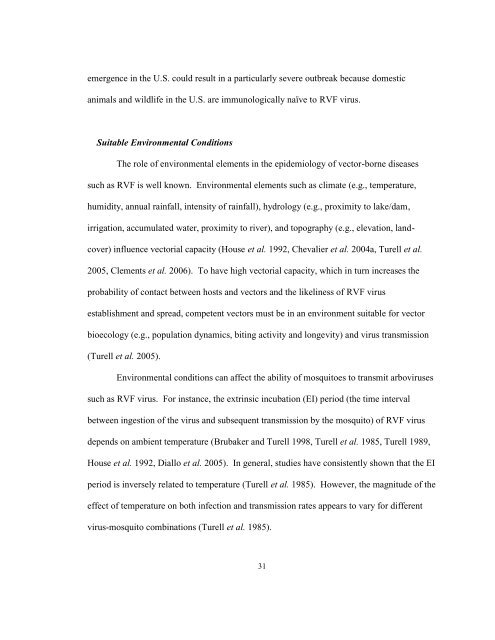Sample A: Cover Page of Thesis, Project, or Dissertation Proposal
Sample A: Cover Page of Thesis, Project, or Dissertation Proposal
Sample A: Cover Page of Thesis, Project, or Dissertation Proposal
Create successful ePaper yourself
Turn your PDF publications into a flip-book with our unique Google optimized e-Paper software.
emergence in the U.S. could result in a particularly severe outbreak because domestic<br />
animals and wildlife in the U.S. are immunologically naïve to RVF virus.<br />
Suitable Environmental Conditions<br />
The role <strong>of</strong> environmental elements in the epidemiology <strong>of</strong> vect<strong>or</strong>-b<strong>or</strong>ne diseases<br />
such as RVF is well known. Environmental elements such as climate (e.g., temperature,<br />
humidity, annual rainfall, intensity <strong>of</strong> rainfall), hydrology (e.g., proximity to lake/dam,<br />
irrigation, accumulated water, proximity to river), and topography (e.g., elevation, land-<br />
cover) influence vect<strong>or</strong>ial capacity (House et al. 1992, Chevalier et al. 2004a, Turell et al.<br />
2005, Clements et al. 2006). To have high vect<strong>or</strong>ial capacity, which in turn increases the<br />
probability <strong>of</strong> contact between hosts and vect<strong>or</strong>s and the likeliness <strong>of</strong> RVF virus<br />
establishment and spread, competent vect<strong>or</strong>s must be in an environment suitable f<strong>or</strong> vect<strong>or</strong><br />
bioecology (e.g., population dynamics, biting activity and longevity) and virus transmission<br />
(Turell et al. 2005).<br />
Environmental conditions can affect the ability <strong>of</strong> mosquitoes to transmit arboviruses<br />
such as RVF virus. F<strong>or</strong> instance, the extrinsic incubation (EI) period (the time interval<br />
between ingestion <strong>of</strong> the virus and subsequent transmission by the mosquito) <strong>of</strong> RVF virus<br />
depends on ambient temperature (Brubaker and Turell 1998, Turell et al. 1985, Turell 1989,<br />
House et al. 1992, Diallo et al. 2005). In general, studies have consistently shown that the EI<br />
period is inversely related to temperature (Turell et al. 1985). However, the magnitude <strong>of</strong> the<br />
effect <strong>of</strong> temperature on both infection and transmission rates appears to vary f<strong>or</strong> different<br />
virus-mosquito combinations (Turell et al. 1985).<br />
31




![[Sample B: Approval/Signature Sheet] - George Mason University](https://img.yumpu.com/21978828/1/190x245/sample-b-approval-signature-sheet-george-mason-university.jpg?quality=85)


![[Sample B: Approval/Signature Sheet] - George Mason University](https://img.yumpu.com/18694905/1/190x245/sample-b-approval-signature-sheet-george-mason-university.jpg?quality=85)






![[Sample B: Approval/Signature Sheet] - George Mason University](https://img.yumpu.com/18694552/1/189x260/sample-b-approval-signature-sheet-george-mason-university.jpg?quality=85)


![[Sample B: Approval/Signature Sheet] - George Mason University](https://img.yumpu.com/18694474/1/190x245/sample-b-approval-signature-sheet-george-mason-university.jpg?quality=85)